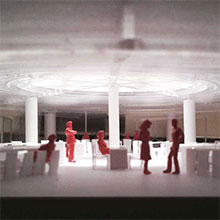The University of Tokyo is implementing “Academic Commons”, the University of Tokyo New Library Plan, which will substantially expand the current General Library at the Hongo Campus in order to create a new hub for excellence in education and research.
An entirely new building will be constructed beneath the area in front of the current library entrance, whilst a full scale renovation of the main building’s interior will preserve the original exterior of the historically significant structure.
The University of Tokyo has various initiatives under way to found a new academic hub for future generations. We have already started various endeavors.
Project Overview

New Library’s Goals
1) Combining the Digital Library and Traditional Library
A new building will be constructed beneath the area in front of the entrance to the General Library and will house an extensive automated storage and retrieval system with the capacity to hold approximately 3 million volumes. This will free up space inside the main building for a greater number of additional acquisitions in the future. Furthermore, it will create a new “hybrid library” in which users can move freely between digital information and physical publications.
The automated storage system will hold an extensive collection of back issues of art, humanities and social science journals in a centralized location for all faculties and departments. Users can order the journals held in the storage system and receive them at the counter in the main library. The existing closed stacks in the main library will also be renovated into a brighter and more accessible space. The New Library will meet users’ needs by enhancing its capabilities as an academic library.
2) Establishing a World Leading Asian Studies Research Library

The fourth floor of the main building will house an Asian Studies Research Library that brings together academic materials, rare books and special collections of the highest order. This will foster an environment for attracting international researchers to carry out world leading research in Asian Studies.
→What is the “Asian Research Library”?
3) Supporting Collaborative and International Education

The “Library Plaza” on basement 1 floor of the new building will provide a communicative space to support student active learning and dynamic research. This will help link the education reforms and internationalization initiatives that the University of Tokyo is promoting.
4) Providing Japan’s Academic Culture to the World

A number of Japan’s most important museums and universities are dotted around Shinobazu Pond in the Ueno and Hongo area. The New Library has plans to closely align itself with these neighboring cultural institutions and play a role in providing Japanese culture to the world.
5) Acting as a Public Foundation of Publishing Culture

In today’s era of digital media, print culture is undergoing a vast transformation. The New Library will contribute to the advancement of academic knowledge by continuing to proceed with large-scale digitalization whilst ensuring the storage and utilization of physical publications at the same time. The library will carry out its role of acting as a public foundation within Japanese society for ensuring the preservation of established knowledge.
Project Timeline

Initiatives of the Project
Digital Project
- Improve the environment for accessing academic resources and construct an integrated infrastructure for university-wide digital information resources.
- Establishment of an academic archive centering on the works of University of Tokyo faculty from past to present.
- Contribute to the training system of digital librarians and collaborate with the University Museum and the University Archives based on digital humanities.
- Establishment of a general archive of academic materials for East Asia Research.
Cultural Landscape, Safety and Environmental Responsibilities
The development and construction plan wil be carried out under the University’s long-term vision in full collaboration with the campus planning office. Complete consideration will be given to safety, materials and the surounding environment during the process.



















